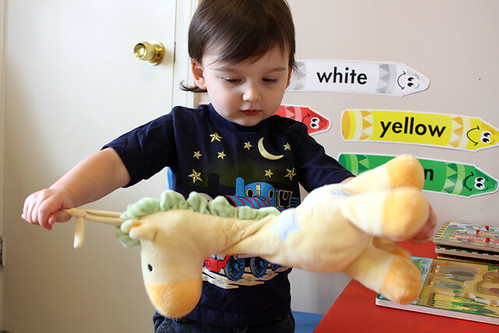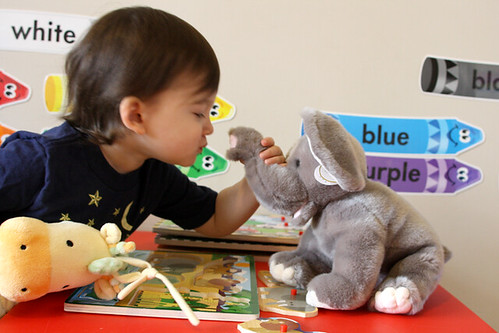Ok, so over the past couple days I have been reading up on the MMR vaccine and the diseases themselves. I was quite shocked to find out that the diseases are NOT very serious at all. The way people stress getting the MMR shot you would think that there are deaths every day from the measles, mumps or rubella. But shock of all shocks, that isn't the case. Below I have listed out some facts about each disease that doctor Sears shares with us in his book.
Look, the first picture! This giraffe is one that he received when he was still in my tummy. He has some control issues, so he loves that he can control when the music comes on by pulling it.
 Gotta start the post out right. Now that you have had your first dose of cuteness, lets move on to the interesting stuff.
Gotta start the post out right. Now that you have had your first dose of cuteness, lets move on to the interesting stuff.***Disclaimer: The information about vaccines in this post came from The Vaccine Book by Robert Sears. I am in the process of reading the book and I am simply sharing as I learn. I strongly recommend doing your own research before deciding if vaccines are right for your child.***
Measles:
Is a virus that travels throughout the body and causes a fever, rash, runny nose, and cough. Transmitted like the common cold and infection usually creates lifelong immunity.
Is not common anymore. In the early part of the twentieth century there were about a million cases every year in the United States. Now there are only about 50 to 100 cases each year.
Is no longer considered endemic in the United States (constantly present in a specific population or area at considerable levels). It now occurs only as isolated outbreaks.
Usually not serious. Most cases (especially in children) pass in a week or so without any trouble. However, approx. 1 in 1000 cases is fatal.
It can infect various internal organs and cause a number of complications. There are all extremely rare. The possible complications from measles, mumps, or rubella are very similar to the side effects of the vaccines themselves. Rarely, measles can infect the brain and cause brain damage.
Is not treatable. The illness must run its course. If a child becomes seriously ill and is hospitalized, high-dose vitamin A therapy can be used to lessen the duration and severity of the disease.
Mumps:
Is a virus very similar to measles. Causes fever, rash, and swelling of the saliva glands in the cheeks. The swelling of the cheeks is usually the most telling sign of mumps, and a blood test can be done to confirm the diagnosis.
Is not common. Only 250 cases have been reported each year throughout the last decade in the United States. In the early twentieth century there were several hundred thousand cases each year.
Is not serious. Most kid who have mumps have some fever and a slight rash but not enough for anyone to worry about or even make a diagnosis. For teens and adults mumps can be more serious. Males may have sore, swollen testicles, and me or women can have arthritis, kidney problems, heart problems, or nervous system dysfunction. Very rarely, the disease can make adults (both men and women) sterile.
Is not treatable. Like the measles, it must run its course.
Rubella:
Like measles and mumps, rubella is a virus that causes a fever and rash. It can also cause aching joints and swelling of the glands behind the ears and in the neck. The disease is so mild in children that it often goes unnoticed. A blood test can confirm the diagnosis. It is transmitted like the common cold and a person catches rubella only once in a lifetime.
Vaccines for rubella are given to protect pregnant women. If a pregnant woman catches rubella (she would be susceptible if she'd never had the disease or if the rubella vaccine she got as a child had worn off), it can infect her fetus and cause birth defects. So the vaccine is mainly given to protect teachers and mothers and their soon-to-be-born babies. Rubella is most risky to a fetus during the first trimester.
Rubella is not common. There used to be 100,000 cases a year, but with universal vaccination it decreased to about 250 cases each year. In the past few years only about 20 cases have been reported each year in the United States.
** Interesting fact: Over the past two decades, about 10 babies have been born with CRS (congenital rubella syndrome) each year. In the past few years, this has declined to only about three babies each year. In 1990 there was an unexplained jump in rubella to 1125 reported cases. This resulted in 34 babies born with rubella birth defects each year for the next two years. (Doctor Sears explains this in the book to illustrate what could happen if rubella came back as a common disease.)
Rubella is not serious. Its virtually unrecognizable in children, and usually harmless for adults. It is not a fatal disease. However, some of the birth defects in a fetus are permanent (hearing loss, heart, eye, and brain defects, and growth problems). Rubella can also cause stillbirth.
No treatment is given to infected people. The virus just has to run its course.
Is everyone still awake? Good. Now, you may take a brief brake and look at this picture of my son giving his elephant a kiss. (This elephant was given to him at the hospital by three of my friends from highschool!)

And now you can see a picture of Zachariah making his giraffe give his elephant a kiss.
The MMR Vaccine:
It is given at twelve or fifteen months old, with a booster dose at five years.
It is a live virus vaccine. The viruses in the vaccine are whole and living.
Includes the following ingredients in the final vaccine solution:
It is a live virus vaccine. The viruses in the vaccine are whole and living.
Includes the following ingredients in the final vaccine solution:
- The three viruses
- Saline solution, sugars, and gelatin
- Human albumin (blood proteins)
- Residual cow fetus serum
- Neomycin (an antibiotic)
- Traces of chick embryo proteins
- "Other buffer and media ingredients" (details are not listed in the product insert)
It causes common reactions (general aches, milk rash and fever) to about one in twenty children. The book has a very long list of other rare complications. For fear of putting you all to sleep, I will not be listing those out. :)
There are some VERY controversial ingredients involved in the making of this vaccine. If I try to paraphrase what Dr. Sears explained in the book I will end up just confusing everyone. So I am going to just type it all out word for word. That way if you are confused it is Dr. Sears' fault, not mine. :)
"Hold onto your seats. This may be the most complicated manufacturing process so far.
I could not determine where the measles and mumps viruses originally came from, but they probably came from infected individuals many decades ago. The rubella virus was originally taken from an infected aborted fetus in the 1960's.
The measles and mumps viruses are nourished for years in a culture of chicken embryo cells. The rubella virus is nourished in a culture of human lung cells. Each of these tissue cultures is contained in a solution of saline, amino acids, vitamins, serum from a cow fetus, sugar, gelatin, neomycin (an antibiotic), and finally, human albumin (a protein filtered out of donated human blood units).
The cell cultures, cow fetus serum, and human blood proteins are tested to make sure no errant infectious germs are present. Then the three viruses are removed from the cultures in batches and put into the vaccine solution. They are alive but weakened so they won't (usually) cause an actual infection when injected.
Why is the process so complicated? The numerous nutrients are needed to keep the chicken embryo cells and human lung cells alive so that the viruses can keep using the cells to multiply."
Did you all catch the whole thing about the rubella virus being taken from an infected ABORTED FETUS? Um... yeah.
Reasons to get this vaccine:
Measles is a disease with some possibly serious side effects and its fatality rate is something to consider (about 1 in 1000 cases). Rubella, while harmless to children and adults, can cause birth defects or stillbirth. Vaccinating children limits the exposure to pregnant women.
Reasons some people choose not to get this vaccine:
Measles is now extremely rare and in most cases harmless. The chance that a child will catch measles and be one of the rare fatalities is extremely low. Mumps and rubella are mild diseases in children, and both are rare. Some parents don't worry about vaccinating for diseases that are both mild and rare.
The main reason some parents worry about this vaccine is that the potential side effects, although rare, can be considerable when they do occur. The human and cow blood products used in manufacturing may also concern some parents. (Um, I would definitely be one of those parents.)
Closing paragraph from Doctor Sears:
Although there are three diseases involved in this vaccine, parents do have the option to get each component separately, so it makes sense to consider each disease individually. Measles can be serious at any age, but it usually isn't and its very rare. Mumps is serious mainly after childhood, and its a little more common than measles. Rubella is a completely harmless to disease to children and adults alike, but it would cause more and more birth defects if allowed to escalate in our country.
While each disease is very different, the separate vaccines are quite similar. The unusual manufacturing process and potential side effects (though very rare) of each vaccine understandably give some parents pause. Given the bad press for the MMR vaccine in recent years, I'm not surprised when a family, especially one with a history of autoimmune or neurologic disease or with one autistic child already, tells me they don't want the MMR or at least want to split it up or delay it. Since the fatality or complication rates for these childhood diseases are fairly low, I don't have much ammunition with which to try to change these parents' minds. I do point out that the mumps can be serious when their kids grow up, and rubella may be an issue for their older daughters someday, and I urge them to do blood testing to determine the need for these shots later on. I also warn them not to share their fears with their neighbors, because if too many people avoid the MMR, we'll likely see the diseases increase significantly."
My opinion:
Oh boy. Where do I even start? The ingredient list horrifies me. The side effects make me nervous. The link between MMR and autism scares me (which Dr. Sears touches on in the book, but not much.). This has been a long post, so I wont ramble on for too long. But I will say that after reading this chapter I am SO glad I decided to not let Zachariah get this vaccine at the age they wanted to give it. I probably wont allow him to have this vaccine until he is about to go to school. I am very glad I did not listen to other people when making my choice about Zachariah receiving the MMR. I am thankful that I listened to my "mommy gut".
And for the record, I will be doing a separate post on the dangers of animal and human tissues/blood in our vaccines. It is definitely cause for concern. *gag*





2 comments:
ugh! i can hardly read it all. bryan got his MMR shot at his 3 year old appointment. i really didn't want him to have it, but felt pressure from our doc. thankfully, the only side effect he had was a fever for 12 hours and then a rash for a couple of days. when i was little and had the MMR i had an allergic reaction and haven't had one since. i think it has spooked me forever and of course the autism link doesn't help.
I'm not gonna lie, I didn't read this. But I do love that the elephant was featured. :)
Post a Comment